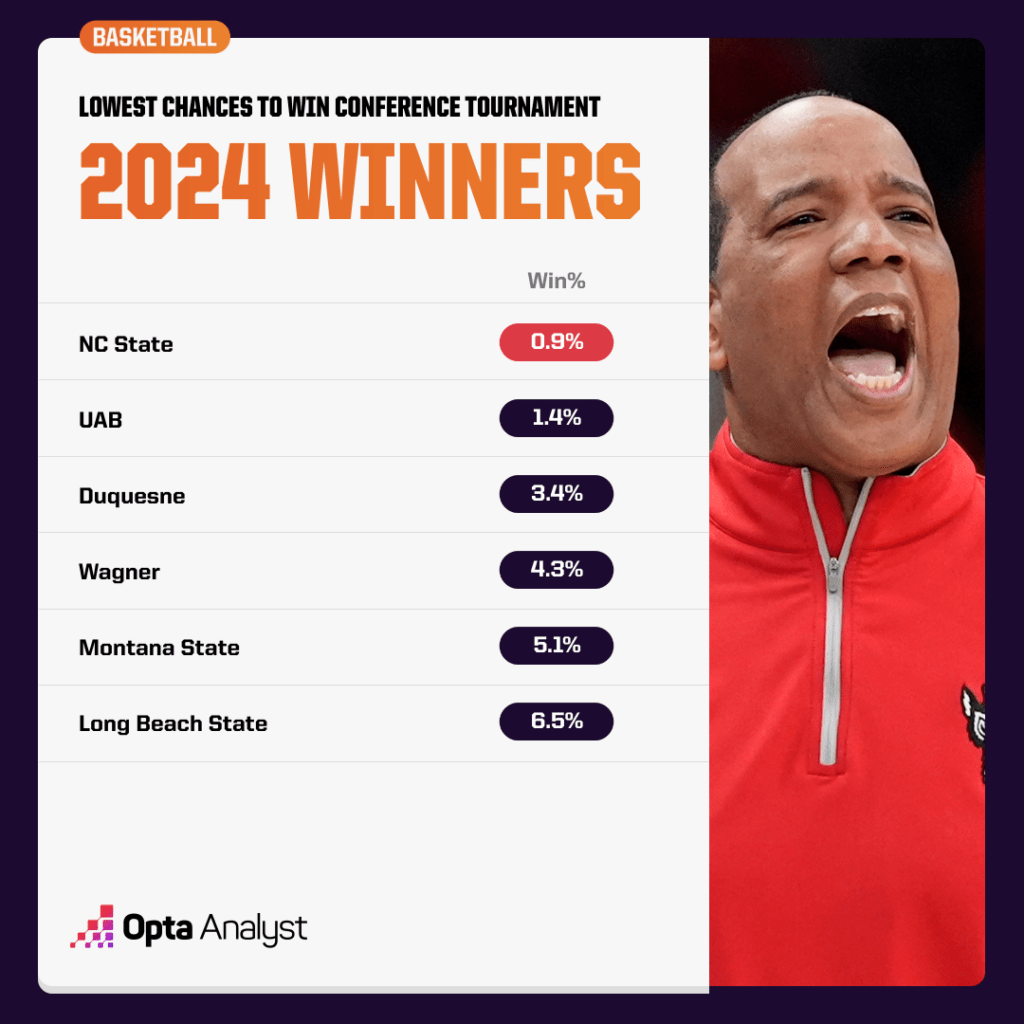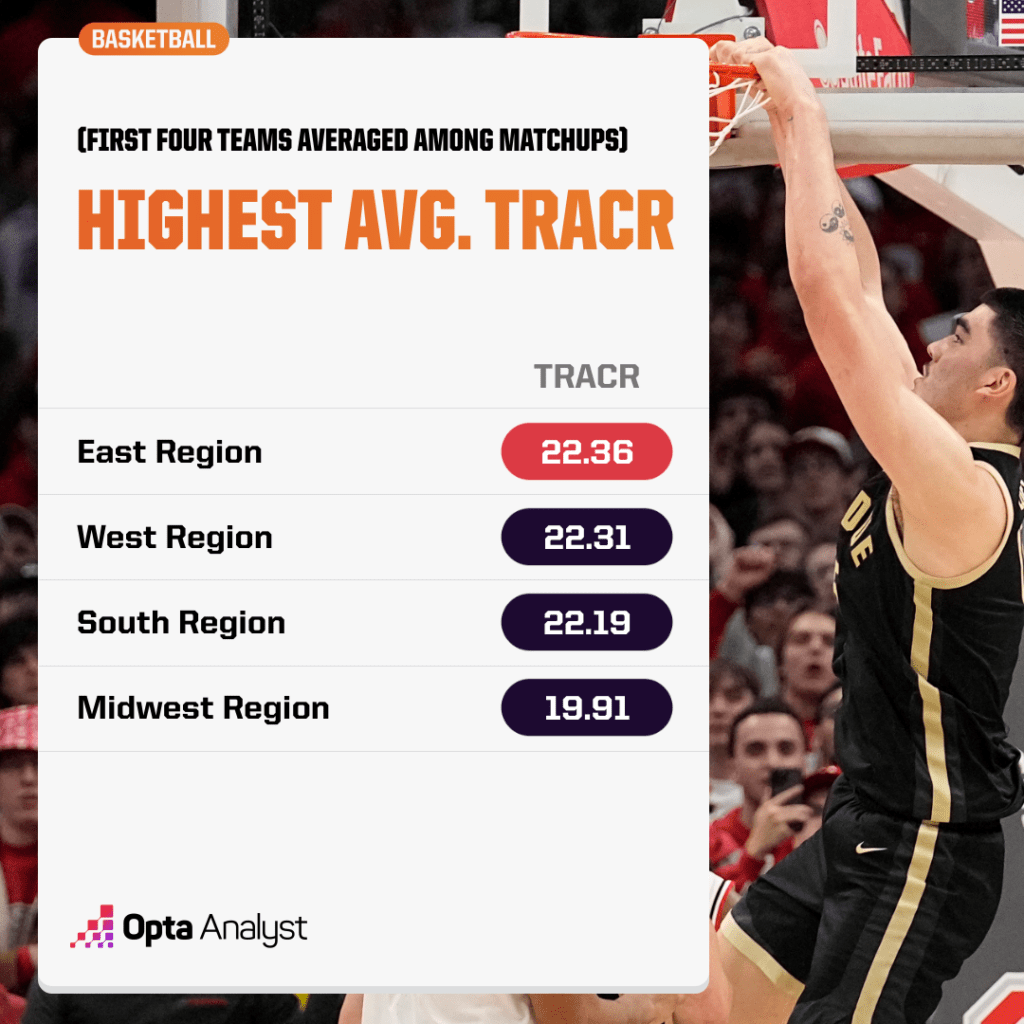With the help of our TRACR model, we’ve calculated the probabilities of advancement for each team in the field. So if you’re looking for 2024 March Madness predictions, you’re in the right place.
After more than four months of basketball, 32 conference tournaments, buzzer-beating shots and all-around chaos, the time has finally come for the NCAA Tournament.
Oh, it could be fun having more college basketball chaos in the next three weeks. Last year, a No. 1-seeded team did not advance to the Final Four, a 16 seed won for just the second time ever and a 15 seed reached the Sweet 16.
This is the place for men’s and women’s NCAA Tournament bracket predictions. Our TRACR-powered supercomputer is simulating both tournaments. TRACR, our Team Rating Adjusted for Conference and Roster, is a net efficiency metric that calculates a team’s points per possession on both sides of the ball, adjusted by the team it plays. The model rewards teams that do well against good teams and subtracts from those that do poorly against weaker squads.
Let’s break down the NCAA men’s basketball tournament, the events leading up to it and reveal our round-by-round probabilities of advancement for each team.
Conference Tournament Darlings
Brown (170th in our TRACR rankings) was so close to winning the Ivy League Tournament after beating Princeton and losing to Yale at the buzzer. TRACR gave Brown just a 7.4% chance to win the tournament. You know why they call them free throws? Because they’re free. Make them!
Yale’s reward for surviving is a first-round date with red-hot SEC Tournament champion Auburn. The Tigers, who are riding a six-game winning streak, have an 87.6% win probability in the opener.
After going 3-8 to end the regular season, Wisconsin (21st) ran off three straight wins in the Big Ten Tournament before falling to Illinois (16th) in an amazing title game. The Badgers were ranked as high as sixth in the country this season, and the tournament showed what they are capable of in March Madness.
They crushed Maryland (95th) by 31 points, cruised to a win over Northwestern (46th), then beat Purdue (No. 5) in OT that felt like an 8-on-5 matchup. The key? A.J. Storr, who averaged 22.5 points in the conference tournament. He may have to bring Wisconsin’s offense to a new level against a tough James Madison team in the first round, in which the Badgers have a 64.3% win probability (per TRACR).
While those teams lost in their tournament championship, there were still a few who needed to win the title to dance and did.

What an incredible run for North Carolina State (51st), which needed five wins in the ACC Tournament and highlighted by victories over Duke (10th), Virginia (66th), and North Carolina (No. 6). This came after the Wolfpack ended the regular season losing four in a row. Their win against the Cavaliers was especially wild. Once again, make your free throws! The DJs – big man DJ Burns Jr. and DJ Horne – could be fan favorites in the tournament.
The 11th-seeded Wolfpack, however, are the underdogs against No. 6 Texas Tech in the first round. Our supercomputer gives the Red Raiders a 63.9% chance of advancing.
We’ve seen quality UAB teams over the last few years, but this Blazers squad needed a little chaos in the AAC Tournament to get in. They beat top-seeded South Florida to advance to the championship game, but were able to face 11th-seed Temple (190th) to win the title. UAB somehow avoided TRACR’s top teams in the conference: FAU (40th), Memphis (62nd), North Texas (76th) and SMU (81st).
The Blazers figure to have their hands full in the opening round against No. 5 San Diego State, which is one of three 2023 Final Four teams in the region. TRACR gives the Aztecs a 70.2% probability of advancing to the second round.
Perhaps one of the wildest stories this March Madness will center around Long Beach State (144th), which won the Big West Tournament as a 4 seed. Like NC State, the Beach came into its tournament on a losing streak, ending the regular season with five straight defeats. It’s likely the losing streak is why the school announced head coach Dan Monson would no longer be coaching after the season.
Firing a guy who went on to lead them to March Madness? Awkward!
Long Beach State, a 15 seed, will face second-seeded Arizona. The Beach will have to pull off a colossal upset to advance to the Round of 32, as our model gives the Wildcats an 88.8% chance of winning. That’s the sixth-most lopsided matchup of the first round, according to TRACR.
The Play-ins
As a result of the conference tournament chaos, a bunch of hopeful teams on the bubble got pushed out on Selection Sunday. The Big East only ended up with three teams in the tournament, as St. John’s (23rd), Providence (61st) and Seton Hall (71st) fell on the wrong side of the bubble. Pittsburgh (24th) and Oklahoma (41st) were on many predicted brackets, but fell just short. Perhaps the biggest omission of the NCAA Tournament was Indiana State (32nd), which fell in the Missouri Valley Conference title game after having a tremendous season.
The committee, however, recognized the last four teams to get in are strong. This is the first time since the First Four (originally first round) was created in the 2011 NCAA Tournament that the last four at-large teams received a 10 seed – typically the last four get 11 or 12 seeds. Since its introduction, a team out of the First Four has won a second game in all but one tournament, and two teams that played in the First Four have gone on to the Final Four (VCU in 2011 and UCLA in 2021).
Will the Mountain West get another win with Boise State (28th) and Colorado State (50th) in Dayton? If both teams lose in their respective play-in games, it might spell trouble for the rest of the teams in the conference. TRACR, however, gives the Broncos a slight edge (50.5%) in their matchup with fellow No. 10 Colorado and the Rams a 57.9% chance of knocking off No. 10 Virginia in their First Four matchups.
Colorado (37th) is one of the last four in after losing to Oregon (59th) in the Pac-12 title game. Cody Williams, a projected NBA lottery pick, pushes this Buffaloes squad up a tier when healthy. Virginia (66th) is the weakest team among the four, per TRACR, but squeezed into the tourney after going 13-7 in ACC play.
Rise of the Mountain West?
Last season, San Diego State (27th) represented the Mountain West Conference in the NCAA Tournament title game. Perhaps that run helped the conference get six teams in the tourney this year. That’s a record for the MWC and more bids than the ACC (five), Big East (three) and Pac-12 (four).
All six teams had at least 22 regular-season wins and 10 conference wins. They are all ranked in the top 40 in the NET and five of them (SDSU, New Mexico, Nevada, Boise State and Colorado State) are in the top 50 in TRACR (Utah State is 56th). Still, the weaker lower half of the conference puts the Mountain West behind the major conferences in Division I.
Want to feel old? New Mexico is led by Jaelen House, the son of NBA champion Eddie House, and Jamal Mashburn Jr., the son of the former NBA player. The Lobos are led by Richard Pitino, the son of Rick Pitino.
Despite being an 11 seed against No. 6 Clemson out of the ACC, our supercomputer gives New Mexico a healthy 62.1% chance of pulling off the upset.
Highest Average TRACR by Conference
- Big 12 – 23.7
- Big Ten – 18.3
- SEC – 18.0
- Big East – 17.1
- ACC – 16.5
- Pac-12 – 13.6
- Mountain West – 12.5
Since 2019, only the Aztecs have a tournament win among Mountain West teams. Colorado State, Wyoming, Boise State, Nevada and Utah State have combined to go 0-9 since then.
As we mentioned above, the model has Colorado State and Boise State as slight favorites in their play-ins, while San Diego State, New Mexico and Nevada are also favorites in their first-round matchups. Among the conference’s teams to reach the Big Dance, only Utah State is an underdog.
If the conference wants to show it is capable of more than just one run, this is the year to do it.
The Midwest Falls Behind
Last season, the West Region was by far the best region, per TRACR, while the other regions had similar averages. UConn ended up coming out of that region en route to a national title.
It is flipped this season – instead of having one region that dominates, it’s the Midwest Region that falls behind.
The Midwest could still have the eventual champion, no doubt – Purdue and Tennessee (No. 8) are in TRACR’s top 10. Creighton (14th) has also been stellar, and our man Ryan Fagan thinks the Bluejays are Final Four material. Our supercomputer gives them the ninth-best chance of making it to Phoenix (15.9%).
Our model, however, does question the seedings for a few others.

Kansas (22nd), which has a 73.7% win probability against No. 13 Samford, is the No. 4 seed in this region, but it’s the lowest-rated 4 seed in the tournament. Star players Kevin McCullar Jr. and Hunter Dickinson are questionable to play, and the Jayhawks are not deep.
South Carolina (54th) is the lowest-rated 6 seed and has a 51.4% win probability versus Oregon, while Utah State is the lowest 8 seed and only has a 40.3% win probability against 9-seed TCU. Because of the weaker middle seeds, expect some chaos in the first round and then chalk the rest of the way.
Does the East Region look familiar at all? The top half of the region has three of last year’s Final Four teams. We could see a national championship rematch between UConn (No. 2) and San Diego State, or even the Aztecs going back up against Florida Atlantic. The Huskies are in the toughest region for the second straight year, but our model still gives them the best chance of reaching the Sweet 16 of anyone in the field (78.0%). As for reaching the Final Four, the potential path gets a bit tougher, and UConn’s 29.1% chance trails Houston’s tournament-best 36.8% mark.
(Teams showing 0.0% have less than a 0.1% probability of reaching that round.)
Houston (92.4% win probability vs. Longwood), Marquette (81.9% vs. Western Kentucky), Kentucky (82.1% vs. Oakland) and Duke (82.7% vs. Vermont) are the top seeds in the South Region.
The Cougars have also been TRACR’s top team in the country for most of the season and it gives them the best chance of winning it all at 13.9%.
Storylines to Come
There could still be some great storylines, too. Here are a few potential scenarios that would be worth watching.
The Rick Barnes Game
The committee put Tennessee in a potential matchup against Texas in the second round, paving the way for Rick Barnes to face his former team. Barnes, who has led the Volunteers since 2015-16, coached the Longhorns from the 1998-99 season until 2014-15.
He led Texas to the Final Four in 2003, won the Big 12 Coach of the Year four times and has coached two National Player of the Year winners: T.J. Ford and Kevin Durant. Yes, he accomplished all of this and was still fired in 2015.
While Barnes had some success in the NCAA Tournament with Texas, he has yet to make it past the Sweet 16 with Tennessee. Dalton Knecht, who averages 21.1 points, may be the scorer that Barnes has needed to reach another Final Four.
TRACR gives the Vols a 92.2% win probability against pesky Saint Peter’s and Texas a 64.8% chance of reaching the second round.
Last-Year Exits Looking for Wins
Some of these teams seeded 10 or higher may look familiar, as it is not the first time many have danced. They’re looking for revenge and at least one win after losing in the first round last year.
Charleston (75th), for example, went 31-4 last season but lost in the first round to national runner-up San Diego State. The Cougars lost their star player from last season, Dalton Bolon, but still cruised to the CAA title. TRACR gives them a 23.3% chance of upsetting Alabama (17th) in the first round.
Vermont (101st) has reached the NCAA Tournament in three straight years and four of the last five tourneys. Unfortunately, the Catamounts have not had a tournament win since a 2012 play-in game. Their one tournament upset was epic, though.
Grand Canyon (47th) has only been in Division I since 2013-14, but it has its best team ever under Bryce Drew. The Antelopes are 29-4 and cruised to their second consecutive WAC title. They are 0-2 all time in the NCAA Tournament after losing to Gonzaga last year, but they’re looking to do damage as a 12 seed this year. A first-round matchup with No. 5 Saint Mary’s won’t be easy, and our supercomputer gives Grand Canyon a 30.3% win probability.
And, boy, would last year’s tournament have been different had Drake (55th) held its lead over Miami in the first round. The Bulldogs couldn’t hold the advantage in the last minute, and the Hurricanes would go on to the Final Four. Coach Darian DeVries’ son, Tucker, averages 21.8 points, 6.8 rebounds and 3.6 assists.
The 10th-seeded Bulldogs have a first-round date with No. 7 Washington State in the most evenly matched contest entering the tournament. Our model is calling it a 50/50 coin flip.
How Purdue Will Fare
Will this be the year the Boilermakers make a run? Purdue has lost to a 15 seed and a 16 seed in each of the last two tournaments. This year does feel different.
Our model gives the team a 93.8% probability of avoiding that first-round upset this season. And only UConn (96.2%) and North Carolina (95.3%) have higher likelihoods of getting past their first-round opponents.
Yes, Zach Edey is still a beast. He’s followed up his award-winning year in 2022-23 by averaging 24.4 points and 11.7 rebounds this season. One thing to watch with Edey is how refs call him – he averages a nation-high 11.2 free-throw attempts. If a team is able to guard him without fouling, it could be a major difference. One team that could do that is Creighton with three-time Big East Defensive Player of the Year Ryan Kalkbrenner.
Edey’s supporting cast is better, too. Purdue lost to Fairleigh Dickinson last year in part because it went just 5 of 26 from beyond the arc. That squad shot just 32.2% from 3 all season. This Boilermakers team shoots 40.8% from 3, with three different players shooting over 40.0% with at least 100 3-point attempts.
Lance Jones, a transfer from Southern Illinois, has been excellent. Braden Smith, Fletcher Loyer and Trey Kaufman-Renn have all improved in their sophomore years.
Purdue also did well in nonconference play, beating Gonzaga, Tennessee, Marquette (15th), Alabama and Arizona (11th). The Boilermakers are 7-0 versus ranked opponents and a combined 20-4 in Quad 1 and 2 games. This is a better team than last year in a region rated the worst by TRACR. This could be the year Purdue makes it back to the Final Four.
The Boilermakers have the third-best chance in the field of getting there at 28.8%.
Enjoy this? Check out our MLB, NBA and NFL coverage, and follow along on X and Instagram for more.
